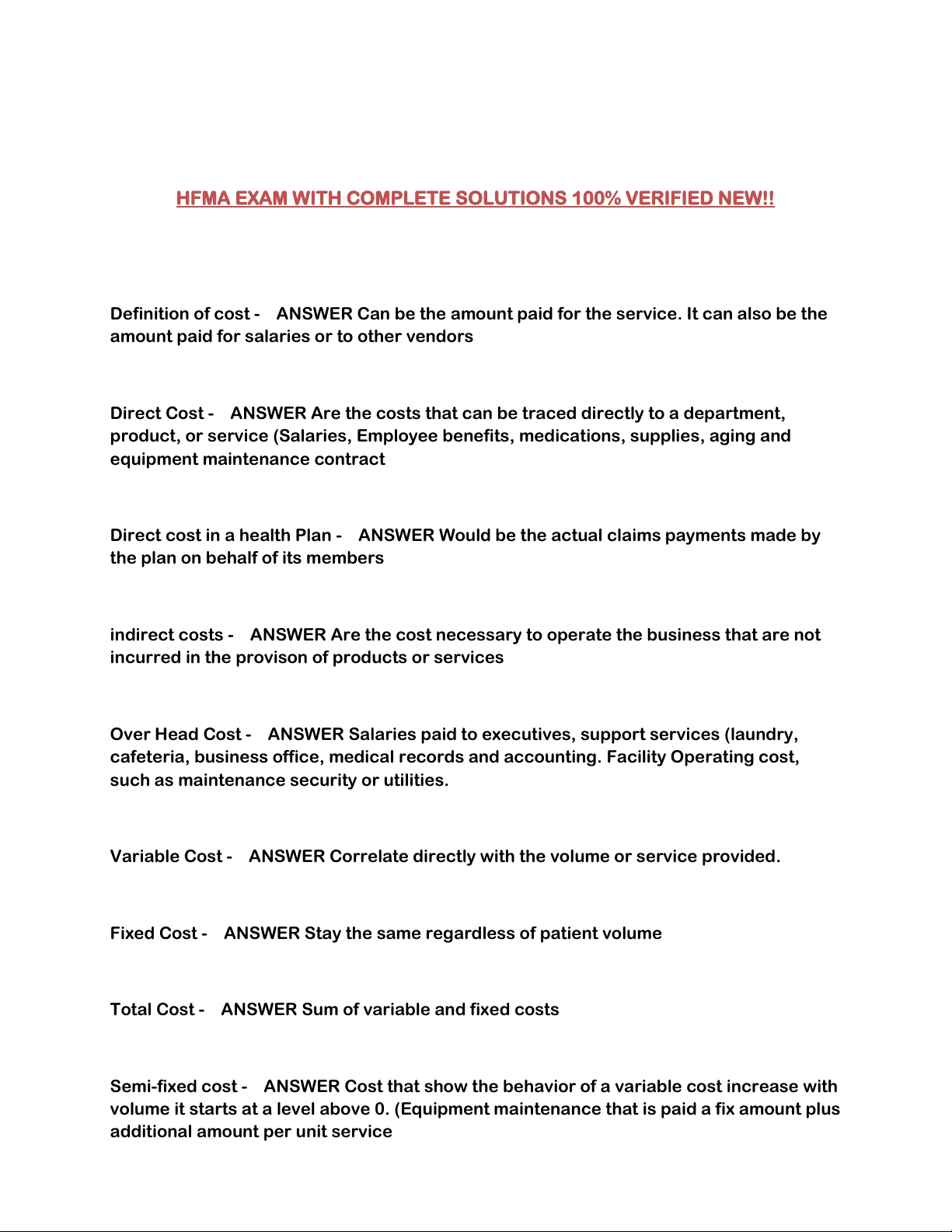








Study with the several resources on Docsity

Earn points by helping other students or get them with a premium plan


Prepare for your exams
Study with the several resources on Docsity

Earn points to download
Earn points by helping other students or get them with a premium plan
Community
Ask the community for help and clear up your study doubts
Discover the best universities in your country according to Docsity users
Free resources
Download our free guides on studying techniques, anxiety management strategies, and thesis advice from Docsity tutors
A comprehensive overview of key healthcare finance concepts and definitions, particularly relevant for preparing for the hfma exam. It covers essential topics such as cost accounting, revenue cycle management, and budgeting, offering explanations and examples to enhance understanding. The document also includes a glossary of terms and a q&a section to reinforce learning.
Typology: Exams
1 / 12

This page cannot be seen from the preview
Don't miss anything!







Definition of cost - ANSWER Can be the amount paid for the service. It can also be the amount paid for salaries or to other vendors
Direct Cost - ANSWER Are the costs that can be traced directly to a department, product, or service (Salaries, Employee benefits, medications, supplies, aging and equipment maintenance contract
Direct cost in a health Plan - ANSWER Would be the actual claims payments made by the plan on behalf of its members
indirect costs - ANSWER Are the cost necessary to operate the business that are not incurred in the provison of products or services
Over Head Cost - ANSWER Salaries paid to executives, support services (laundry, cafeteria, business office, medical records and accounting. Facility Operating cost, such as maintenance security or utilities.
Variable Cost - ANSWER Correlate directly with the volume or service provided.
Fixed Cost - ANSWER Stay the same regardless of patient volume
Total Cost - ANSWER Sum of variable and fixed costs
Semi-fixed cost - ANSWER Cost that show the behavior of a variable cost increase with volume it starts at a level above 0. (Equipment maintenance that is paid a fix amount plus additional amount per unit service
Step Variable cost - ANSWER Cost that remains fixed over a finite level of volume and then increase incrementally at higher volume levels
Cost allocation - ANSWER is a process by which indirect costs are assigned to a part of the organization that actually provides services to a patient or client.
Revenue Producing - ANSWER Directed services providing areas.
Non-revenue/overhead department - ANSWER Area that incure cost
Step Down Approach - ANSWER Considers that interrelationships between overhead departments ( Administration to Housekeeping to Peds)
Direct allocation - ANSWER Housekeeping to adults, administration, accounting.)
Direct and Step-down approaches - ANSWER Are effective in estimating costs at a high level, such as, within an entire clinic, hospital or a department within the organization
Activity - Based Costing (ABC) - ANSWER is a bottom-up or micro costing approach in contrast to an allocation driver, top-down costing method used on the medical cost report
Four steps to activity-based costing - ANSWER 1. Gather total cost and activity stats
Gather total data - ANSWER Establishes a rate per unit of services for the activity the
Average inventory turnover in days - ANSWER 50 to 60 times per year
Days Payable - ANSWER Accounts Payable/(COGS/365)
account payable - ANSWER The liability created by a purchase on account.
Increasing this item will increase cash available - ANSWER Accounts Payable
Deceasing this item will increase cash available - ANSWER Inventory
Short term debt - ANSWER Borrowed capital that must be repaid within a year, and often in 30, 60, or 90 days.
Long term debt - ANSWER any loan or debt obligation with a maturity of more than a year
Pros for Capitation - ANSWER Reduce incentives of fee for service
Encourage providers to maximize efficiency
Cons for Capitation - ANSWER Creates an incentive to limit care
No extra monthly payments for coordinating care
No financial rewards formatting quality goals
Patient-Center Medical Home (PCMH) - ANSWER a team-based model of care led by ha personal physician who provides continuous and coordinated care throughout a patient's lifetime to maximize health outcomes, including appropriately arranging patients' care with other qualified professionals for preventive services, treatment of acute and chronic illness, and assistance with end-of-life issues.
Accountable Care Organization (ACO) - ANSWER a network of doctors and hospitals that shares responsibility for managing the quality and cost of care provided to a group of patients
Quality Payment Program (QPP) - ANSWER Established by the Medicare and CHIP Reauthorization Act of 2015 (MACRA), the QPP allows physicians to select participation in one of two CMS system options that define the way in which they will be reimbursed for services under Medicare: either the Medicare incentive payment program (MIPS) or the alternative payment model (APM).
Bundle Payments - ANSWER Reimbursement of health care providers (hospitals and physicians) on the basis of expected costs for clinically-defined episodes of care
Middle ground between fee-for-service and capitation (providers are paid lump sum per patient regardless of how many services the patient receives)
Three types of Bundle Payments - ANSWER Voluntary Bundled Payments
Mandatory Care
Voluntary Oncology Care Model
Business Intelligence Implementation - ANSWER Data Strategy
Data Availability
Data Integrity
break-even analysis - ANSWER Fixed cost / Contribution margin Example: $20k / $50 = 400
Planning vs. Budgeting (Planning) - ANSWER Entails preparing the business for future operations in a a big picture sense
Planning vs. Budgeting (Budgeting) - ANSWER Is a subset of the planning process and is intended to express the organizations plans in financial terms.
expense budget - ANSWER outlines the anticipated and actual expenses for a responsibility center
What percent of operating expenses comes from medical claims when it comes to Health Plans? - ANSWER 80%
cost center - ANSWER Support area that usually do not generate revenues tend to insure indirect costs
What is the overall result of the operating budget? - ANSWER to get an estimate of the margin to be expected in the coming year
capital budget - ANSWER budget for major capital, or investment, expenditures
Two different capital budgets - ANSWER Maintenance Capital
Strategic Capital
Maintenance Capital - ANSWER is a capital investment made to replace an existing capabilities or maintain current service levels are examples of maintenance capital
Strategic Capital - ANSWER is a capital investment made to expand capacity, capabilities, or enter new service lines
Net Present Value - ANSWER estimates the present value of the future cash inflow and outflows associated with the assets and subtracts from the assets's current acquisition cost
Payback Period - ANSWER The length of time that it takes for a project to fully recover its initial cost out of the net cash inflows that it generates.
Cash budget - ANSWER Details of the expected sources and uses of cash by a
business as a part of its annual budget
simple variance analysis - ANSWER uses the budget as prepared before the beginning of the fiscal period and completes the variance between the budget projection and the actual results.
Flexible Variance Analysis - ANSWER Requires the manager to adjust the budget for changes in volumes by applying revenue and expense-per-unit standards to the actual volumes are known
Flexible budget variance analysis - ANSWER This requires the manager to adjust the budget for changes in volume by applying revenue and expense-per-unit standard to the actual volume (actual results - budgeted projection (flexed) = variance
Insurers, regulators, and suppliers are - ANSWER Participants in the delivery of medical care that are no directly involved in treatment
Purchasing healthcare is a process best described as - ANSWER The purchaser is likely to contract with a third party to pay for services
The "revenue cycle" in health care is - ANSWER The flow of money between the patient, the insurer and the health care services provider
Prior to passage of the Patient Protection and Affordable Care Act (PPACA), that insurance was usually provided by an employer to the employee an additional form of compensation, known as - ANSWER An Employee Benefit
Insurers usually require some out-of-pocket payment by the patient to - ANSWER incentive patients to use services on when necessary
Medicare is over seen by - ANSWER The federal Centers for Medicare and Medicaid Services (CMS)
Price - ANSWER The total amount the provider expects to be paid by payers and patients for healthcare services
Payer - ANSWER An organization the negotiates or sets rates for providers services collects revenue through premium payments or tax dollars, processes provider claims from service, and pays provider claims using collected premium
Balance billing - ANSWER The practice of billing patients for any balance left after deductibles, coinsurance, and insurance payments have been made.
price transparency - ANSWER the ease with which consumers can find out the variety of prices in a market
Volume - ANSWER The quantity of a healthcare service in relation to the total price paid for the service by care purchasers
Reimbursement - ANSWER Payment by a n insurer to a hospital or physician
Days net revenue - ANSWER Net patients services accounts receivable / (net patients services revenues / number of days in the period)
Billed charges - ANSWER The price set by a hospital or physician for their services. Retail prices = Charge Master
Billed Charges - ANSWER Charges at retail prices
Net Revenue - ANSWER Price - discounts to insures medicare or medicaid
fee-for-service - ANSWER a system under which doctors and hospitals receive a payment for each service they provide
Cost based Payment - ANSWER Calls for the insurer to pay the hospital based on the costs of providing services, with a nominal allowance for margin
Issues with cost based payings - ANSWER reduced demand for providers must be efficient
Future payments - ANSWER DRG, Reb Procedures, Case Rate, Per diem, Bundled payments
DRG - ANSWER diagnostic related group- a method of classification employed by medicare and other third-party payers to categorize illness according to diagnosis and treatment There are approximately 750 different classifications
case rate - ANSWER A reimbursement method utilized that provides a set payment rate to the hospital for a case. The payment rate is based on the type of case and resources utilized to treat the patient.
per diem (hospital) - ANSWER A fixed amount per day for care for the patient.
concurrent review - ANSWER review of medical justification and obtaining a certification of necessity for the patient's continued stay.
Bundled Payments - ANSWER category of payments made as lump sums to providers for all healthcare services delivered to a patient for a specific illness and/or over a specified time period; they include multiple services and may include multiple providers of care
Capitation - ANSWER System of payment used by managed care plans in which physicians and hospitals are paid a fixed, per capita amount for each patient enrolled over a stated period regardless of the type and number of services provided; reimbursement to the hospital on a per-member/per-month basis to cover costs for the members of the plan.